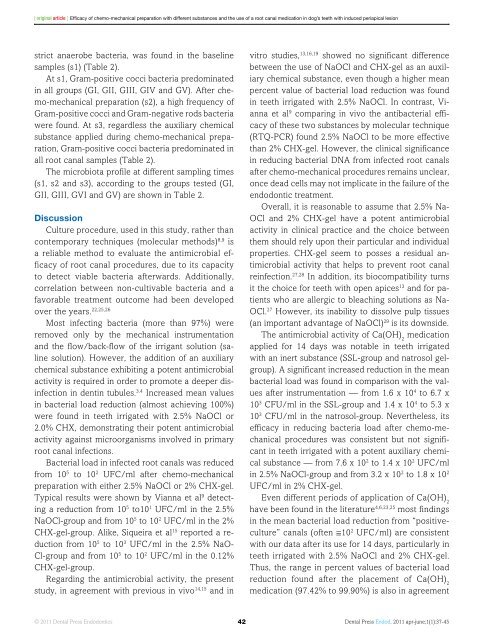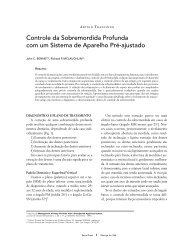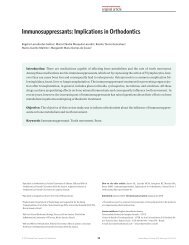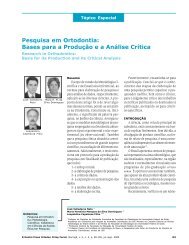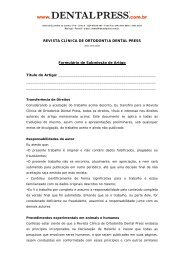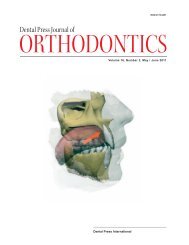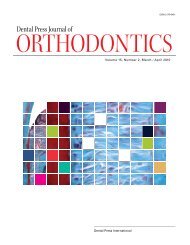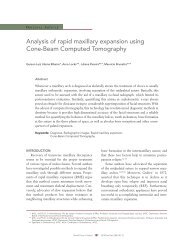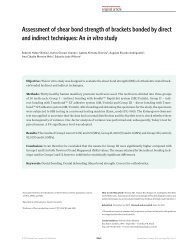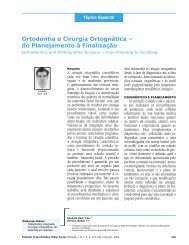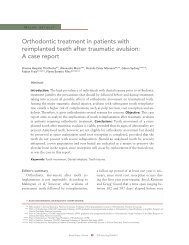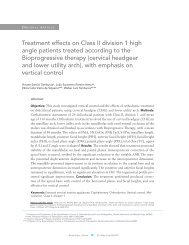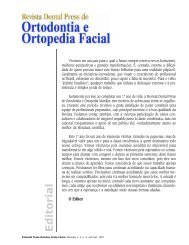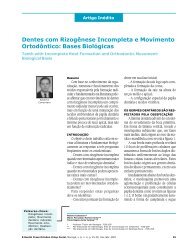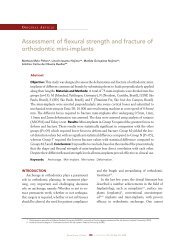Dental Press
Dental Press
Dental Press
Create successful ePaper yourself
Turn your PDF publications into a flip-book with our unique Google optimized e-Paper software.
[ original article ] Efficacy of chemo-mechanical preparation with different substances and the use of a root canal medication in dog’s teeth with induced periapical lesion<br />
strict anaerobe bacteria, was found in the baseline<br />
samples (s1) (Table 2).<br />
At s1, Gram-positive cocci bacteria predominated<br />
in all groups (GI, GII, GIII, GIV and GV). After chemo-mechanical<br />
preparation (s2), a high frequency of<br />
Gram-positive cocci and Gram-negative rods bacteria<br />
were found. At s3, regardless the auxiliary chemical<br />
substance applied during chemo-mechanical preparation,<br />
Gram-positive cocci bacteria predominated in<br />
all root canal samples (Table 2).<br />
The microbiota profile at different sampling times<br />
(s1, s2 and s3), according to the groups tested (GI,<br />
GII, GIII, GVI and GV) are shown in Table 2.<br />
Discussion<br />
Culture procedure, used in this study, rather than<br />
contemporary techniques (molecular methods) 8,9 is<br />
a reliable method to evaluate the antimicrobial efficacy<br />
of root canal procedures, due to its capacity<br />
to detect viable bacteria afterwards. Additionally,<br />
correlation between non-cultivable bacteria and a<br />
favorable treatment outcome had been developed<br />
over the years. 22,25,26<br />
Most infecting bacteria (more than 97%) were<br />
removed only by the mechanical instrumentation<br />
and the flow/back-flow of the irrigant solution (saline<br />
solution). However, the addition of an auxiliary<br />
chemical substance exhibiting a potent antimicrobial<br />
activity is required in order to promote a deeper disinfection<br />
in dentin tubules. 3,4 Increased mean values<br />
in bacterial load reduction (almost achieving 100%)<br />
were found in teeth irrigated with 2.5% NaOCl or<br />
2.0% CHX, demonstrating their potent antimicrobial<br />
activity against microorganisms involved in primary<br />
root canal infections.<br />
Bacterial load in infected root canals was reduced<br />
from 10 5 to 10 2 UFC/ml after chemo-mechanical<br />
preparation with either 2.5% NaOCl or 2% CHX-gel.<br />
Typical results were shown by Vianna et al 9 detecting<br />
a reduction from 10 5 to10 1 UFC/ml in the 2.5%<br />
NaOCl-group and from 10 5 to 10 2 UFC/ml in the 2%<br />
CHX-gel-group. Alike, Siqueira et al 15 reported a reduction<br />
from 10 5 to 10 3 UFC/ml in the 2.5% NaO-<br />
Cl-group and from 10 5 to 10 2 UFC/ml in the 0.12%<br />
CHX-gel-group.<br />
Regarding the antimicrobial activity, the present<br />
study, in agreement with previous in vivo 14,15 and in<br />
vitro studies, 13,16,19 showed no significant difference<br />
between the use of NaOCl and CHX-gel as an auxiliary<br />
chemical substance, even though a higher mean<br />
percent value of bacterial load reduction was found<br />
in teeth irrigated with 2.5% NaOCl. In contrast, Vianna<br />
et al 9 comparing in vivo the antibacterial efficacy<br />
of these two substances by molecular technique<br />
(RTQ-PCR) found 2.5% NaOCl to be more effective<br />
than 2% CHX-gel. However, the clinical significance<br />
in reducing bacterial DNA from infected root canals<br />
after chemo-mechanical procedures remains unclear,<br />
once dead cells may not implicate in the failure of the<br />
endodontic treatment.<br />
Overall, it is reasonable to assume that 2.5% Na-<br />
OCl and 2% CHX-gel have a potent antimicrobial<br />
activity in clinical practice and the choice between<br />
them should rely upon their particular and individual<br />
properties. CHX-gel seem to posses a residual antimicrobial<br />
activity that helps to prevent root canal<br />
reinfection. 27,28 In addition, its biocompatibility turns<br />
it the choice for teeth with open apices 13 and for patients<br />
who are allergic to bleaching solutions as Na-<br />
OCl. 27 However, its inability to dissolve pulp tissues<br />
(an important advantage of NaOCl) 29 is its downside.<br />
The antimicrobial activity of Ca(OH) 2<br />
medication<br />
applied for 14 days was notable in teeth irrigated<br />
with an inert substance (SSL-group and natrosol gelgroup).<br />
A significant increased reduction in the mean<br />
bacterial load was found in comparison with the values<br />
after instrumentation — from 1.6 x 10 4 to 6.7 x<br />
10 3 CFU/ml in the SSL-group and 1.4 x 10 4 to 5.3 x<br />
10 3 CFU/ml in the natrosol-group. Nevertheless, its<br />
efficacy in reducing bacteria load after chemo-mechanical<br />
procedures was consistent but not significant<br />
in teeth irrigated with a potent auxiliary chemical<br />
substance — from 7.6 x 10 2 to 1.4 x 10 2 UFC/ml<br />
in 2.5% NaOCl-group and from 3.2 x 10 2 to 1.8 x 10 2<br />
UFC/ml in 2% CHX-gel.<br />
Even different periods of application of Ca(OH) 2<br />
have been found in the literature 4,6,23,25 most findings<br />
in the mean bacterial load reduction from “positiveculture”<br />
canals (often ≅10 2 UFC/ml) are consistent<br />
with our data after its use for 14 days, particularly in<br />
teeth irrigated with 2.5% NaOCl and 2% CHX-gel.<br />
Thus, the range in percent values of bacterial load<br />
reduction found after the placement of Ca(OH) 2<br />
medication (97.42% to 99.90%) is also in agreement<br />
© 2011 <strong>Dental</strong> <strong>Press</strong> Endodontics 42<br />
<strong>Dental</strong> <strong>Press</strong> Endod. 2011 apr-june;1(1):37-45


